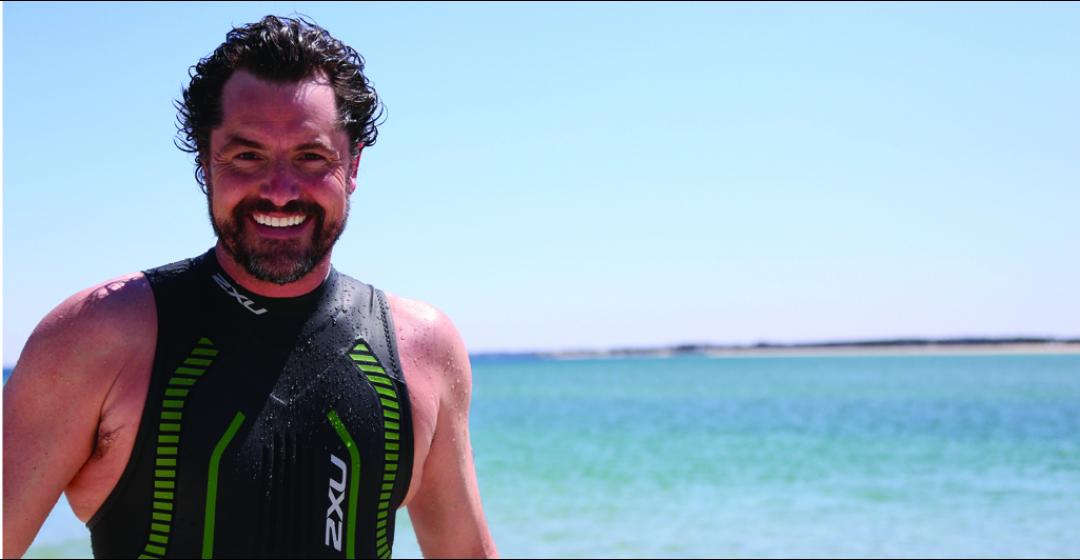One thing is clear when you meet 42-year-old Dean Bragonier on a windy late-spring afternoon at State Beach beside Big Bridge: he’s up for a challenge. He zips up his wetsuit, plunges into the cold blue-green water, swims out a few dozen yards and back, and emerges with an invigorated smile on his face.
The quick dip was just a tease compared to the much bigger plunge he will take on July 11, when he begins a fifty-mile “’Round the Island Swim.” The idea for that journey, which will be comprised of twenty-seven legs swum over the course of thirty-eight days, came after an East Chop to West Chop swim that he did last summer, around the time he created NoticeAbility, a nonprofit organization that produces curricula for dyslexic students. A dyslexic himself, Bragonier thought a swim would be an ideal fundraiser for the organization.
“And then I thought, there’s no glory in doing East Chop to West Chop; let’s do the whole Island!” he said. “These sort of physical challenges tend to garner a level of curiosity, and this is the one sport that I love.”
Growing up with dyslexia was a constant struggle for Bragonier – especially in educational settings. “I had a fundamental feeling of being the misfit in the traditional education system,” he said. “I did not understand at seven or eight years old that this was a neurological issue.”
A particularly bright spot in his childhood was the Vineyard, where he visited his Sayre cousins and worked summers as a lifeguard at Lucy Vincent Beach. It was there that he met his future wife, the artist Sally Taylor. After college he returned to the Island and, at age 23, opened the Amity Café in Oak Bluffs.
“The moment I entered the entrepreneurship world I recognized that my dyslexia was a tremendous advantage. Not only had it allowed me to forge a strong work ethic, but it allowed me to find creative solutions to problems that others couldn’t figure out,” he said. “I felt like I had tapped into some dormant superpower.”
Inspired by the book The Dyslexic Advantage, by Brock L. and Fernette F. Eide, he now believes that the way a dyslexic’s mind works can be an asset in four key areas: entrepreneurship, engineering, architecture, and narrative storytelling.
“Why don’t we introduce those earlier in the education career so that we can create pre-vocational subtext,” he thought, “instilling them down to a middle school level and making them accessible so that they can understand what they are inherently good at?”
With that in mind, he created NoticeAbility (noticeability.org), named for the notion: “If you notice my ability, you will see no disability.” NoticeAbility designs curricula specifically geared toward the dyslexic mind, with an eye toward playing on the dyslexic’s strengths rather than remediating the perceived weaknesses. NoticeAbility’s website highlights this potential with several statistics: 25 percent of CEOs, 35 percent of entrepreneurs, and 50 percent of billionaires have dyslexia.
“You look at those individuals who have been able to find their strengths and then imagine all those dyslexics that are in atrophy or in jail or rehab – and imagine if one of them had the potential to grow into Charles Schwab, Albert Einstein, or Steven Spielberg?”
Since January, Bragonier has been swimming alongside a Harvard University masters team in Cambridge, training six days a week in preparation for the ’Round the Island Swim. With the help of Nat Benjamin, Buddy Vanderhoop, and others, he’s been studying charts and currents to determine the route, which will begin and end at the Little Bridge on State Beach. He’ll be joined in the swim on various legs by friends and supporters, some of them well known. “The best part is the final leg on August 16,” he said. “For me it’s the last leg, but anybody who feels they can do that length of the swim can join me.”
Of course, there are some unpredictable, albeit low, risks that come with the swim – inclement weather, turbulent waves, men-o’-war, sharks – but true to form, Bragonier remains undeterred.
“It takes far more courage for a middle school student to go to school every day,” he said with his trademark big smile, “than it does for me to go into the water.”




 1 comment
1 comment
Comments (1)